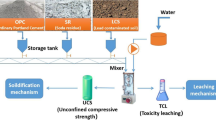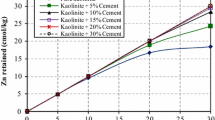Abstract
Cement stabilization/solidification (s/s) is a widely used remediation technology for lead-contaminated sites. However, the physical and chemical transformations caused by carbonation may affect the long-term effectiveness of s/s. This work presents the effect of carbonation on the performance of cement-stabilized lead-contaminated soils. Artificially contaminated soils with different lead contents were stabilized using cement, and a series of semi-dynamic leaching tests, unconfined compressive tests and microstructure tests were performed on carbonated and non-carbonated samples. The experimental results showed that carbonation decreased the effective diffusion coefficient and leached concentration of lead, resulting in 16–36% increase in strength, 13–44% increase in secant modulus and 3.5–6.4% reduction in porosity, and lowering pH values in the pore solution from 11–12 to 8–9. Increasing initial lead content from 0.1 to 2.5% resulted in a marked increase in the effective diffusion coefficient of lead. The variations in lead leaching and strength upon carbonation could be well interpreted by the thermogravimetric analysis, X-ray diffraction analysis and scanning electron microscope results. The main leaching mechanism of lead release in cement-stabilized soils was diffusion, for both carbonated and non-carbonated specimens. Cement was very effective in immobilizing lead, and the cement matrix could be performed much better in retaining lead upon carbonation.














Similar content being viewed by others
References
Al-Tabbaa A, Boes N (2002) Pilot in situ auger mixing treatment of a contaminated site: part 4. Performance at five years. Proc Inst Civ Eng Geotech 155:187–202
Al-Tabbaa A, Evans CW (1998) Pilot in situ auger mixing treatment of a contaminated site: part 1. Treatability study. Proc Inst Civ Eng Geotech 131:52–59
ANS (2003) Measurement of the leachability of solidified low-level radioactive wastes by a short-term test procedure. ANSI/ANS 16.1, American Nuclear Society, La Grandge Park, IL
Ashraf W (2016) Carbonation of cement-based materials: challenges and opportunities. Constr Build Mater 120:558–570
ASTM (2001) Standard test method for pH of soils. ASTM D4972, American Society for Testing and Materials, West Conshohocken, PA
ASTM (2008a) Standard method for accelerated leach test for diffusive release from solidified waste and a computer program to model diffusive, fractional leaching from cylindrical waste forms. ASTM C1308, American Society for Testing and Materials, West Conshohocken, PA
ASTM (2008b) Standard test method for unconfined compressive strength index of chemical grouted soils. ASTM D4219, American Society for Testing and Materials, West Conshohocken, PA
ASTM (2010) Standard test methods for liquid limit, plastic limit, and plasticity index of soils. ASTM D4318, American Society for Testing and Materials, West Conshohocken, PA
ASTM (2011) Standard practice for classification of soils for engineering purposes (Unified Soil Classification System). ASTM D2487, American Society for Testing and Materials, West Conshohocken, PA
ASTM (2012) Standard test methods for laboratory compaction characteristics of soil using standard effort (12400 ft-lbf/ft3(600 kN-m/m3)). ASTM D698, American Society for Testing and Materials, West Conshohocken, PA
Bensted J, Barnes P (2002) Structure and performance of cements. Spon Press, New York
Boardman DJ (1999) Lime stabilization: clay-metal-lime interactions. Dissertation, Loughborough University, Loughborough, UK
Branch JL, Kosson DS, Garrabrants AC, He PJ (2016) The impact of carbonation on the microstructure and solubility of major constituents in microconcrete materials with varying alkalinities due to fly ash replacement of ordinary Portland cement. Cem Concr Res 89:297–309
Chen QY, Ke YJ, Zhang LN, Tyrer M, Hills CD, Xue G (2009) Application of accelerated carbonation with a combination of Na2CO3 and CO2 in cement-based solidification/stabilization of heavy metal-bearing sediment. J Hazard Mater 166:421–427
Chen L, Du YJ, Liu SY, Jin F (2011) Evaluation of cement hydration properties of cement-stabilized lead-contaminated soils using electrical resistivity measurement. J Hazard Toxic Radioact Waste 15:312–320
Consoli NC, Foppa D, Festugato L, Heineck KS (2007) Key parameters for strength control of artificially cemented soils. J Geotech Geoenviron Eng 133:197–205
Du YJ, Jiang NJ, Liu SY, Jin F, Singh DN, Pulppara AJ (2014a) Engineering properties and microstructural characteristics of cement solidified zinc-contaminated kaolin clay. Can Geotech J 51:289–302
Du YJ, Wei ML, Reddy KR, Jin F, Wu HL, Liu ZB (2014b) New phosphate-based binder for stabilization of soils contaminated with heavy metals: leaching, strength and microstructure characterization. J Environ Manag 146:179–188
Du YJ, Wei ML, Reddy KR, Liu ZP, Jin F (2014c) Effect of acid rain pH on leaching behavior of cement stabilized lead-contaminated soil. J Hazard Mater 271:131–140
Environment Canada (1991) Proposed evaluation protocol for cement-based solidified wastes. Environmental Protection Series, report no. EPS 3/HA/9
Gervais C, Garrabrants AC, Sanchez F, Barna R, Moszkowicz P, Kosson DS (2004) The effects of carbonation and drying during intermittent leaching on the release of inorganic constituents from a cement-based matrix. Cem Concr Res 34:119–131
Gerven TV, Cornelis G, Vandoren E, Vandecasteele C (2007) Effects of carbonation and leaching on porosity in cement-bound waste. Waste Manag 27:977–985
Hekal EE, Hegazi WS, Kishar EA, Mohamed MR (2011) Solidification/stabilization of Ni(II) by various cement pastes. Constr Build Mater 25:109–114
Johannesson B, Utgenannt P (2001) Microstructural changes caused by carbonation of cement mortar. Cem Concr Res 31:925–931
Kogbara RB, Al-Tabbaa A (2011) Mechanical and leaching behavior of slag-cement and lime-activated slag stabilised/solidified contaminated soil. Sci Total Environ 409:2325–2335
Lange LC, Hills CD, Poole AB (1996) The effect of accelerated carbonation on the properties of cement-solidified waste forms. Waste Manag 16:757–763
Malviya R, Chaudhary R (2006) Leaching behavior and immobilization of heavy metals in solidified/stabilized products. J Hazard Mater 137:207–217
Moon DH, Dermatas D (2006) An evaluation of lead leachability from stabilized/solidified soils under modified semi-dynamic leaching conditions. Eng Geol 85:67–74
NEN (2004) Leaching characteristics of moulded or monolithic building and waste materials: Determination of leaching of inorganic components with the diffusion test. NEN 7375, Netherlands Normalisation Institute, Delft
Pandey B, Kinrade SD, Catalan LJJ (2012) Effects of carbonation on the leachability and compressive strength of cement-solidified and geopolymer-solidified synthemic metal wastes. J Environ Manag 101:59–67
Pizzol VD, Mendes LM, Frezzatti L, Savastano H, Tonoli GHD (2014) Effect of accelerated carbonation on the microstructure and physical properties of hybrid fiber-cement composites. Miner Eng 59:101–106
Rostami V, Shao YX, Boyd AJ, He Z (2012) Microstructure of cement paste subject to early carbonation curing. Cem Concr Res 42:186–193
Shafique MSB, Walton JC, Gutierrez N, Smith RW, Tarquin AJ (1998) Influence of carbonation on leaching of cementitious waste forms. J Environ Eng 124:463–467
Sharma HD, Reddy KR (2004) Geoenvironmental engineering: site remediation, waste containment, and emerging waste management technologies. Wiley, Hoboken, NJ
Tommaseo CE, Kersten M (2002) Aqueous solubility diagrams for cementitious waste stabilization systems 3: mechanism of zinc immobilisation by calcium silicate hydrate. Environ Sci Technol 13:2919–2925
Torras J, Buj I, Rovira M, Pablo J (2011) Semi-dynamic leaching tests of nickel containing wastes stabilized/solidified with magnesium potassium phosphate cements. J Hazard Mater 186:1954–1960
US EPA (1989) Stabilization/solidification of CERCLA and RCRA wastes—physical tests, chemical testing procedures, technology screening, and field activities. EPA 625/6-89/022, National Service Center for Environmental Protection, Cincinnati
Yilmaz O, Ünlü K, Cokca E (2003) Solidification/stabilization of hazardous wastes containing metals and organic contaminants. J Environ Eng 129:366–376
Zhang DW, Chen L, Liu SY (2012) Key parameters controlling electrical resistivity and strength of cement treated soils. J Cent South Univ 19:2991–2998
Acknowledgements
This work is supported by the National Natural Science Foundation of China (Grant No. 51578148), the Fundamental Research Founds for the Central Universities (Grant No. 2242017K40128, No.2242014R30020), and the Research Innovation Program for College Graduates of Jiangsu Province (No. KYLX16_0241).
Author information
Authors and Affiliations
Corresponding author
Rights and permissions
About this article
Cite this article
Zhang, D., Cao, Z., Zhang, T. et al. Effect of carbonation on leaching behavior, engineering properties and microstructure of cement-stabilized lead-contaminated soils. Environ Earth Sci 76, 724 (2017). https://doi.org/10.1007/s12665-017-7071-1
Received:
Accepted:
Published:
DOI: https://doi.org/10.1007/s12665-017-7071-1




